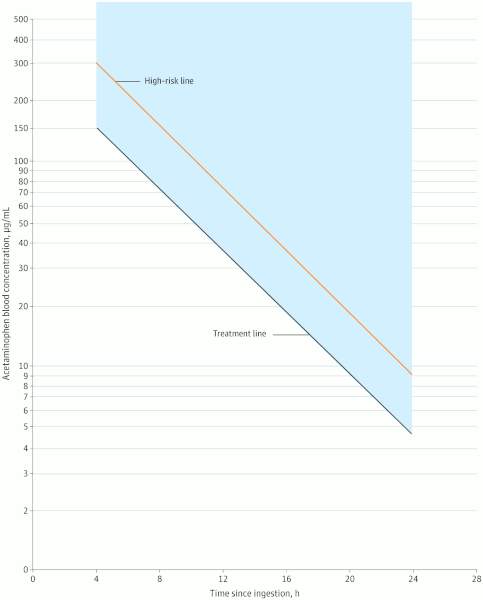Tests
1st tests to order
serum acetaminophen level
Test
In cases of acute overdose, serum acetaminophen concentration should be checked 4 hours after ingestion, or as soon as possible in patients presenting after the 4-hour period.
The 4-hour level of serum acetaminophen relative to the time of ingestion will determine need for subsequent treatment.
[Figure caption and citation for the preceding image starts]: Revised Rumack-Matthew Nomogram for the Acute Ingestion of AcetaminophenDart RC et al. JAMA Netw Open. 2023;6(8):e2327739; used with permission [Citation ends].
In late-presenting patients, the acetaminophen level may be low or undetectable and treatment in these cases should be initiated based on history and supporting laboratory data.
In repeated supratherapeutic ingestion, the level of acetaminophen may be low or undetectable.
Children 6 years or younger very rarely ingest a toxic dose of acetaminophen. If it can be ascertained with absolute certainty that <200 mg/kg has been ingested over a single 24-hour period, it is unnecessary to check an acetaminophen level, unless there are factors that place the child at higher risk.[44]
Result
may or may not be positive
serum aspartate aminotransferase (AST) and alanine aminotransferase (ALT)
Test
Laboratory investigations are done initially and repeated in the course of patient management. The degree of derangement in laboratory results depends on the time of presentation relative to the time of acetaminophen overdose.
The acetaminophen-aminotransferase multiplication product, calculated by multiplying the serum acetaminophen concentration by the aminotransferase activity (AST or ALT, whichever is higher), can potentially complement early assessment of patients who are at low risk of hepatotoxicity.[65] Patients with a multiplication product greater than 10,000 mg/L × IU/L have a high likelihood of developing hepatotoxicity, especially if it is more than 8 hours post ingestion; patients with a multiplication product lower than 1500 mg/L × IU/L have a low likelihood of developing hepatotoxicity.[66][67][68]
Result
may be elevated
Tests to consider
arterial pH and lactate level
Test
Used to monitor severity of hepatic failure and assist in patient stratification for optimal benefit in orthotopic liver transplantation.
Result
may show acidemia; lactate level may be elevated
metabolic panel or serum electrolytes with BUN and creatinine
Test
Monitored during therapy. Used to assess renal function and severity of hepatic failure, and assist in patient stratification for optimal benefit in orthotopic liver transplantation.
Renal injury has been reported in the absence of significant hepatotoxicity, and is relatively common with significant hepatotoxicity.
Rarely, massive overdose of acetaminophen may initially present with coma and metabolic acidosis prior to development of hepatotoxicity.
Result
may show renal impairment or metabolic acidosis
serum prothrombin time and INR
Test
Used to monitor the severity of hepatotoxicity and also to assist in patient stratification for optimal benefit in orthotopic liver transplantation.
A prolonged INR is a poor prognostic sign.[5]
Result
PT may be prolonged; INR may be increased
serum salicylate level
Test
Should be considered in patients who have ingested substances in an attempt at self-harm.
Result
may be elevated
ethanol level
Test
Should be obtained in any patient with altered mental status.
Result
may be elevated
blood glucose level
Test
Should be obtained in any patient with altered mental status.
Result
may be low
lipase level
Test
Elevated lipase consistent with pancreatitis may occur especially in patients with alcohol dependence.
Result
may be elevated
serum phosphate
Test
May be helpful for prognostication for patients with acute liver failure as a supplement (e.g., the King's College Criteria [based on INR, arterial pH, and serum creatinine]). Elevated phosphate is associated with worst outcomes.[70]
Result
may be elevated
Use of this content is subject to our disclaimer